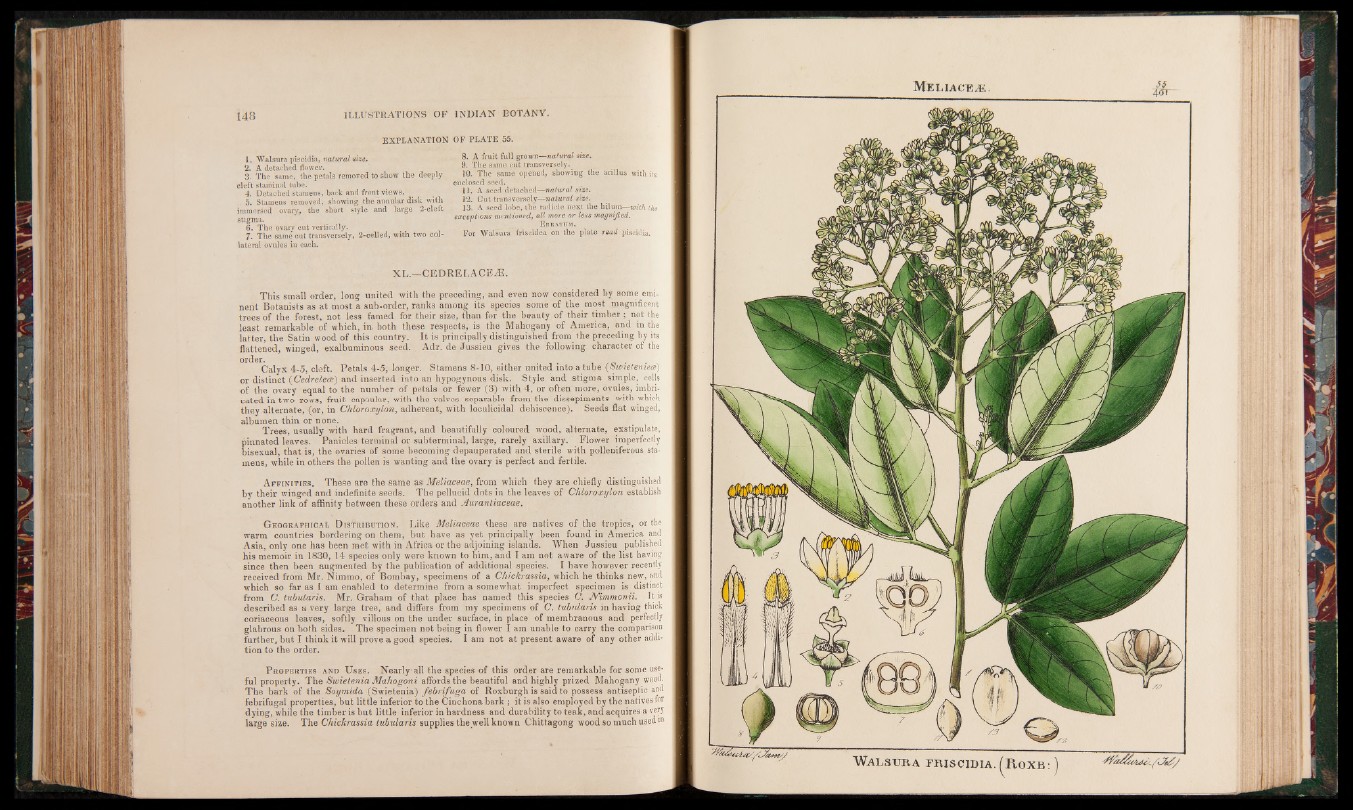
148 ILLUSTRATIONS OF INDIAN BOTANY.
EXPLANATION OF PLATE 55.
1. Walsura piscidia, natural size.
2. A detached flower.
3. The same, the petals removed to show the deeply
cleft staminal tube.
4. Detached stamens, back and front views.
5. Stamens removed, showing the annular disk with
immersed ovary, the short style and large 2-cleft
stigma.
6. The ovary cut vertically.
7. The same cut transversely, 2-celled, with two collateral
ovules in each.
8. A fruit full grown—natural size.
9. The same cut transversely.
10. The same opened, showing the arillus with its
enclosed seed.
11. A seed detached—natural size.
12. Cut transversely—natural size.
13. A seed lobe, the radicle next the hilum—with the
exceptions mentioned, all more or less magnified.
E rratum.
For Walsura friscidea on the plate read piscidia.
XL.—CEDRELACEJS.
This small order, long united with the preceding, and even now considered by some emi-
nent Botanists as at most a sub-order, ranks among its species some of the most magnificent
trees of the forest, not less famed for their size, than for the beauty of their timber; not the
least remarkable of which, in. both these respects, is the Mahogany of America, and in the
latter, the Satin wood of this country. It is principally distinguished from the preceding by its
flattened, winged, exalbuminous seed. Adr. de Jussieu gives the following character of the
order. ■ • •
Calyx 4-5, cleft. Petals 4-5, longer. Stamens 8-10, either united into a tube (Swieteniea)
or distinct (Cedrelece) and inserted into an hypogynous disk. Style and stigma simple, cells
of the ovary equal to the number of petals or fewer (3) with 4, or often more, ovules, imbricated
in two rows, fruit capsular, with the valves separable from the dissepiments with which
they alternate, (or, in Chloroccylon, adherent, with loculicidal dehiscence). Seeds flat winged,
albumen thin or none.
Trees, usually with hard fragrant, and beautifully coloured wood, alternate, exstipulate,
pinnated leaves. Panicles terminal or subterminal, large, rarely axillary. Flower imperfectly
bisexual, that is, the ovaries of some becoming depauperated and sterile with polleniferous sta^
mens, while in others the pollen is wanting and the ovary is perfect and fertile.
Affinities. These are the same as Melictceae. from which they are chiefly distinguished
by their winged and indefinite seeds. The pellucid dots in the leaves of Chloroxylon establish
another link of affinity between these orders and Aurantiaceae.
G eographical D istr ibu t io n . Like Meliaceae these are natives of the tropics, or the
warm countries bordering on them, but have as yet principally been found in America and
Asia, only one has been met with in Africa or the adjoining islands. When Jussieu published
his memoir in 1830, 14 species only were known to him, and I am not aware of the list having
since then been augmented by the publication of additional species. I have however recently
received from Mr. Nimmo, of Bombay, specimens of a Chickrassia, which he thinks new, and
which so far as I am enabled to determine from a somewhat imperfect specimen is distinct
from C. tubularis. Mr. Graham of that place has named this species C. Nimmonii. It is
described as a very large tree, and differs from my specimens of C. tubularis in having thick
coriaceous leaves, softly villous on the under surface, in place of membranous and perfectly
glabrous on both sides. The specimen not being in flower I am unable to carry the comparison
further, but I think it will prove a good species. I am not at present aware of any other addition
to the order.
P roperties and Uses. Nearly all the species of this order are remarkable for some useful
property. The Swietenia Mahogoni affords the beautiful and highly prized Mahogany wood.
The bark of the Soymida (Swietenia) febrifuga of Roxburgh is said to possess antiseptic and
febrifugal properties, but little inferior to the Cinchona bark ; it is also employed by the natives for
dying, while the timber is but little inferior in hardness and durability to teak, and acquires a very
large size. The Chickrassia tubularis supplies the well known Chittagong wood so m u c h used i&
M e l i a c e æ .